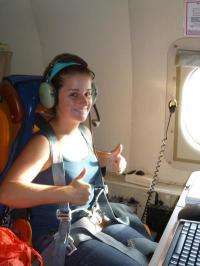Studies of Desoto canyon and shelf in Gulf of Mexico uncover upwelling during Hurricane Isaac

As Hurricane Isaac barreled toward New Orleans, a team led by University of Miami (UM) Professor and Deep-C (Deep Sea to Coast Connectivity in the Eastern Gulf of Mexico) Co-Principal Investigator Nick Shay was planning NOAA's P-3 aircraft missions to fly into the storm. Dr. Benjamin Jaimes and UM graduate students Jodi Brewster and Ryan Shuster prepared and loaded 39 profilers into the plane. Their goal: to drop these profilers into the storm at optimum locations where they could collect measurements of ocean heat content, salinity and currents during the hurricane.
"We wanted to collect data from the DeSoto Canyon area where the Deepwater Horizon incident occurred, so we could capture the upwelling as it was occurring," said Shay, who is an expert on the Loop Current and regularly studies weather in this region. "We used operational products that we developed for NOAA's National Environmental Satellite Data and Information Service (NESDIS) to study the warm and cold core eddy ahead of the storm to establish drop points and deploy three different types of devices that penetrate to depths of 4,500 feet."
Prior to Hurricane Isaac the team flew over the area and deployed 54 devices to collect baseline oceanic and atmospheric data over the shelf and shelf break. After the storm, the team worked with the flight crew at NOAA's Aircraft Operation Center located at McDill Air Force Base to deploy another 67 probes and get a post-hurricane snapshot of the area tying the response from several research flights. The information from each of the flights is being analyzed by scientists, and for input into both research models that are being developed for Deep-C as well as operational models at forecasting centers.
"From previous hurricanes like Ivan and Frederic we knew this area was prone to upwelling, and deep sea responses to the events taking place in the atmosphere. These areas have high humidity and strong surface wind activity, which may lead to tar balls washing, ashore – which may have the same chemical fingerprint as the oil spill. We are interested in this possibility, and the long term impacts it might have on the coastal ecosystem," said Shay.
Hurricane Isaac presented a unique opportunity to investigate that possibility. Since the Deepwater Horizon accident, Deep-C scientists have visited and revisited sites along the Gulf Coast that were affected by the oil spill. A team scoured the beaches as recently as one week before Hurricane Isaac, looking for samples of oil that may have mixed with sand to create what are referred to as "sand patties." Immediately following the storm, those Deep-C teams led by investigators Dr. Chris Reddy of the Woods Hole Oceanographic Institution and Dr. Wade Jeffrey of the University of West Florida, returned to the beaches to collect additional samples.
"Our intent," Reddy said, "is to determine if these post-storm samples contain oil from the Deepwater Horizon spill and, if so, if they are in fact a result of the upwelling and deep sea responses to the recent hurricane."
One of the ways the fate of the oil can be determined is to study an effect called weathering—that is, how oil that is discharged into the environment changes over time. Weathering affects the properties of spilled oil and according to Reddy, oil from the deep bottom will have weathered differently than samples already on the shore prior to the storm that were simply unearthed or exposed by the winds and rain of Hurricane Isaac.
"We are doing a careful and prudent analysis of the samples found to determine if they are, in fact, Deepwater Horizon oil from the deep sea," Reddy added.
The Deep-C consortium is a long-term, interdisciplinary study investigating the environmental consequences of petroleum hydrocarbon release in the deep Gulf of Mexico on living marine resources and ecosystem health. The consortium focuses on the geomorphologic, hydrologic, and biogeochemical settings that influence the distribution and fate of the oil and dispersants released during the Deepwater Horizon accident, and is using the resulting data for model studies that support improved responses to possible future incidents.
The research was made possible by a grant from The Gulf of Mexico Research Initiative (GoMRI). The GoMRI Research Board is an independent body established by BP to administer the company's 10-year, $500 million commitment to independent research into the effects of the Deepwater Horizon incident. Through a series of competitive grant programs, the GRI is investigating the impacts of the oil, dispersed oil, and dispersant on the ecosystems of the Gulf of Mexico and the affected coastal States in a broad context of improving fundamental understanding of the dynamics of such events and their environmental stresses and public health implications.
Provided by University of Miami

















